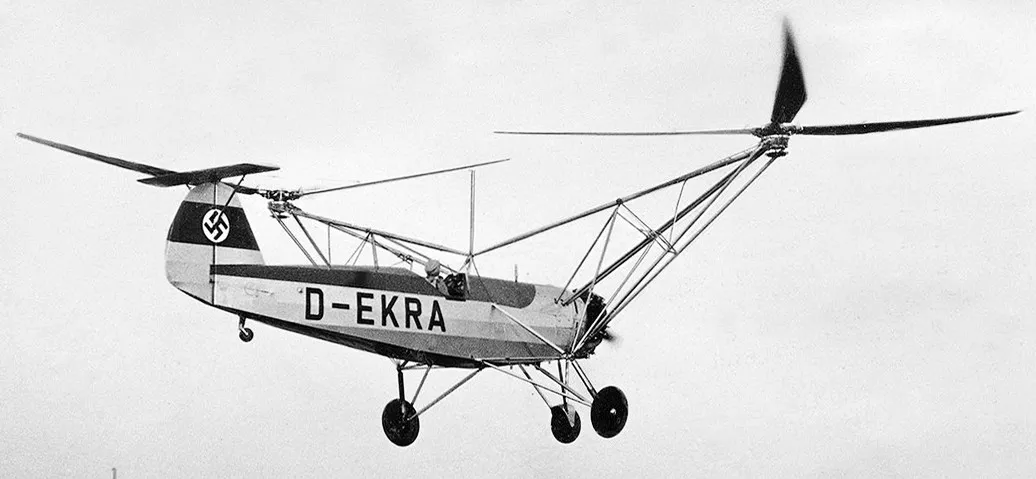Warplanes of Germany: Luftwaffe Focke-Wulf Fw 61
Focke-Wulf Fw 61 helicopter

(Luftwaffe Photo)
Hanna Reitsch flying the Focke-Wulf Fw 61 V2, cFeb 1938.
The Focke-Wulf Fw 61 was the first successful, practical, and fully controllable helicopter, first flown in 1936. It was also known as the Fa 61, as Focke began a new company—Focke-Achgelis—in 1937. Professor Henrich Focke, through his development of the Fw 186, and through theefforts of producing the C.19 and C.30 autogyros under licence,[6] came to theconclusion that the limitations of autogyros could be eliminated only by anaircraft with a powered rotor, the helicopter. He and engineer Gerd Achgelis startedthe design for this helicopter in 1932. A free-flying model, built in 1934 and propelled by a small two-stroke engine, brought the promise of success. Today, the model can be seen in the Deutsches Museum in Munich.
On 9 February 1935, Focke received an order for the building of a prototype,which was designated the Fw 61; Focke referred to it as the F 61. Roluf Luchtof the technical office of the RLM extended the order for a second aircraft on 19 December 1935. The airframe was based on that of a well-tried training aircraft, the Focke-Wulf Fw 44 Stieglitz.
Using rotor technology licensed from the Cierva Autogiro Company, a singleradial engine drove twin rotors, set on tubular steel outriggers to the leftand right of the fuselage. Each main rotor consisted of three articulated and tapered blades, driven by the engine through gears and shafts. Longitudinaland directional control was achieved using cyclic pitch and asymmetric rotorlift The counter-rotation of the two rotors solved the problem oftorque-reaction as also shown by Louis Bréguet. The small horizontal-axis propeller directly driven by the engine was purely to provide the necessary airflow to cool the engine during low speed or hovering flight and providednegligible forward thrust.
Only two aircraft were produced. The first prototype, the V 1 D-EBVU, had itsfirst free flight on 26 June 1936 with Ewald Rohlfs at the controls. By early1937, the second prototype, V 2 D-EKRA, was completed and flown for its firstflight. On 10 May 1937, it accomplished its first autorotation landing with theengine turned off.
Focke-Achgelis began work on a two-seat sports version of the Fw 61, the Fa224, which would have used an Argus As 10C engine and had greater performance.However, the Fa 224 never left the drawing board at the outbreak of the Second World War.


In February 1938, the Fw 61 was demonstrated by Hanna Reitsch indoors at the Deutschlandhalle sports stadium in Berlin, Germany. It subsequently set several records for altitude, speed and flight duration culminating, in June 1938, withan altitude record of 3,427 m (11,243 ft), breaking the unofficial 605 m (1,985ft) altitude record of the TsAGI 1-EA single lift-rotor helicopter from theSoviet Union set on 14 August 1932, and a straight line flight record of 230 km(143 mi). Neither of these machines appear to have survived the Second World War, although a replica is on display at the Hubschraubermuseum in Bückeburg,Germany. (Wikipedia)


(Luftwaffe Photos)
Focke-Wulf Fw 61.





